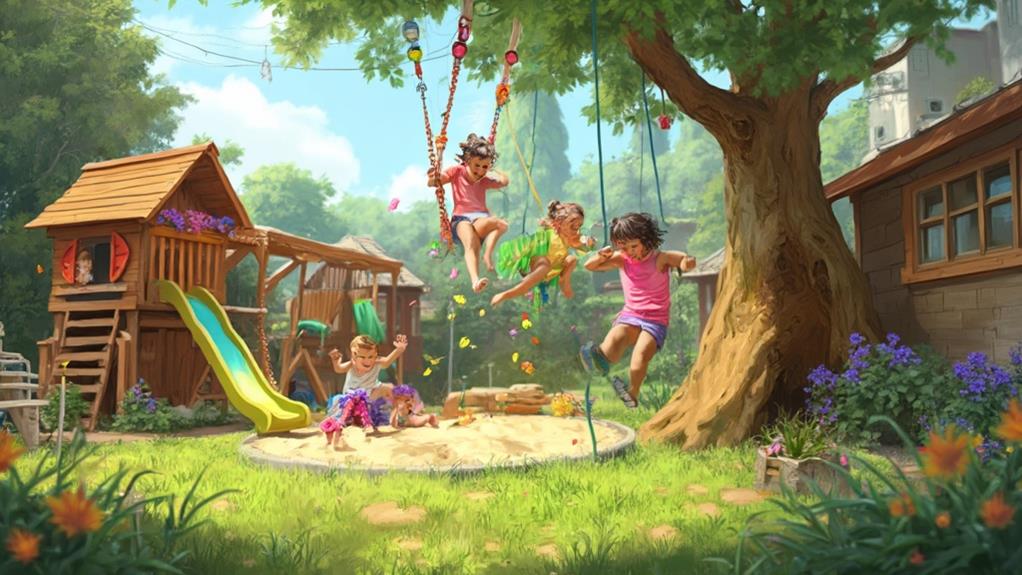Transforming your backyard into an outdoor playroom offers endless possibilities for children's entertainment, education, and development. Key elements include adventure playground equipment with climbing walls and slides, nature-inspired reading nooks for quiet moments, and DIY obstacle courses to promote physical activity. Imaginative play structures, water fun zones, and artistic expression areas cater to diverse interests and skills. Consider incorporating gardening spaces, outdoor science labs, and sports corners to round out the experience. By creating cozy hangout spots, you'll ensure the space appeals to children of all ages. With careful planning, your backyard can become a multifaceted wonderland for young explorers.
Adventure Playground Equipment
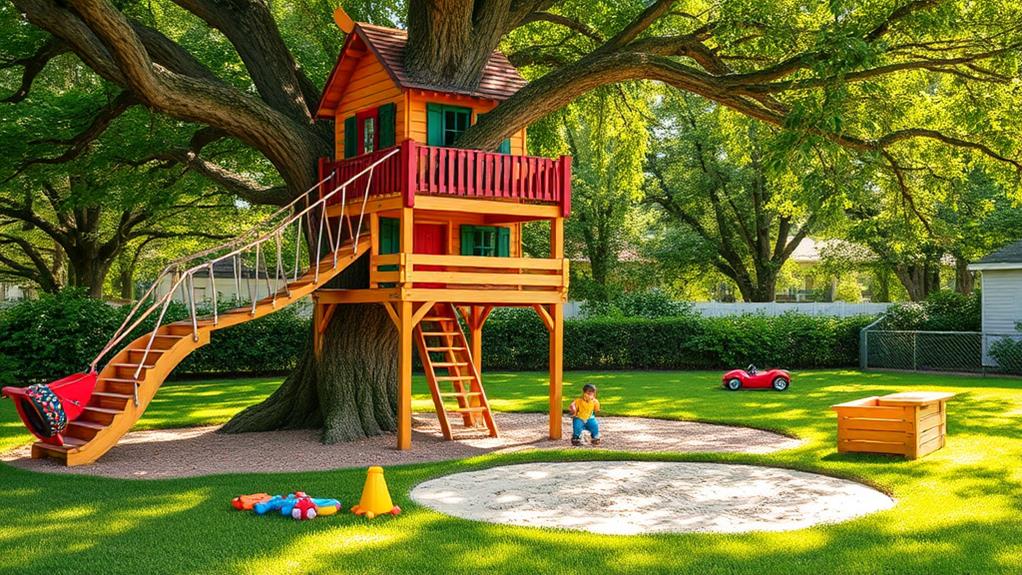
For children with boundless energy, adventure playground equipment transforms an ordinary backyard into an exciting outdoor haven. These structures offer a variety of physical challenges and imaginative play opportunities, encouraging children to stay active and develop motor skills.
A popular choice is the multi-level play system, which typically includes a combination of climbing walls, slides, swings, and monkey bars. These versatile structures can be customized to fit different space requirements and age groups.
For smaller yards, compact options like treehouse-style playsets provide vertical play spaces without sacrificing ground area.
Safety is paramount when selecting and installing playground equipment. Opt for durable materials like treated wood or metal with weather-resistant coatings. Ensure proper anchoring and install impact-absorbing surfaces beneath equipment to minimize injury risks from falls.
Consider incorporating natural elements into the play area, such as log balance beams or boulder-climbing features. These additions blend seamlessly with the landscape and offer unique tactile experiences. For added excitement, include zip lines or rope courses, which challenge older children and promote strength and coordination.
Regular maintenance and inspection of playground equipment are essential to ensure continued safety and longevity, providing years of outdoor enjoyment for children.
Nature-Inspired Reading Nooks
While adventure playgrounds cater to active play, creating a peaceful retreat for quiet activities is equally important in a child-friendly backyard. Nature-inspired reading nooks offer a serene space for children to relax, read, and engage in imaginative play. These cozy corners can be designed to blend seamlessly with the natural surroundings, providing a sense of wonder and tranquility.
To create an enchanting reading nook, consider incorporating natural elements such as tree stumps, large rocks, or reclaimed wood for seating. Suspend a weatherproof canopy or build a small wooden structure to provide shade and protection from the elements. Add comfortable cushions, blankets, and pillows made from durable, outdoor-friendly fabrics to enhance comfort and coziness.
Integrate bookshelves or weatherproof storage containers to house a rotating selection of books and educational materials. Enhance the ambiance with solar-powered fairy lights or lanterns for evening reading sessions. Surround the nook with native plants, flowers, and shrubs to attract butterflies and birds, creating a mini ecosystem that sparks curiosity and fosters a connection with nature. This carefully crafted space will encourage children to develop a love for reading and appreciation for the outdoors.
DIY Obstacle Courses
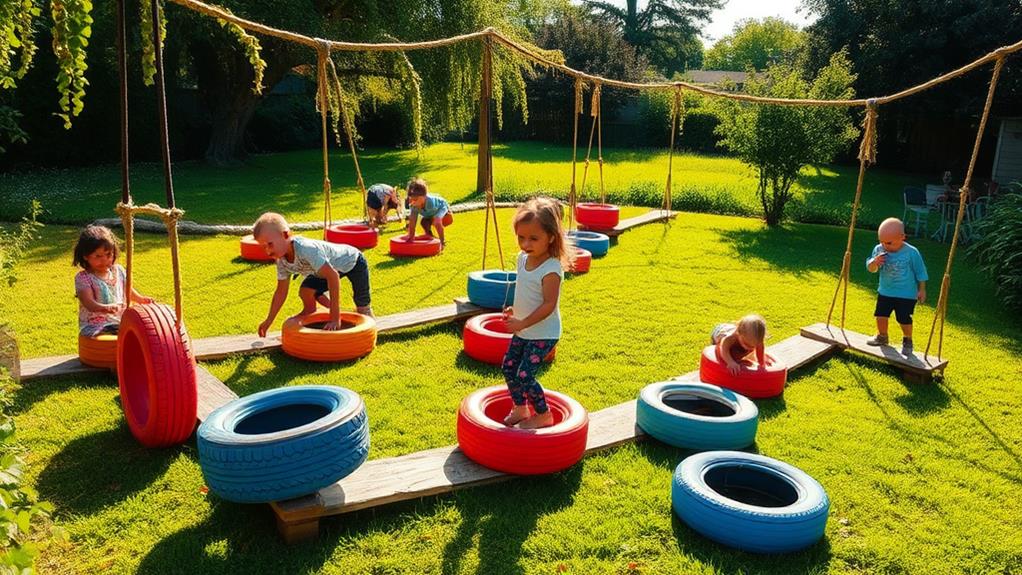
DIY obstacle courses offer an exciting way to promote physical activity and challenge children's motor skills in the backyard. These customizable play areas can be designed using everyday materials and simple structures, making them both cost-effective and adaptable to various age groups.
To create a safe and engaging obstacle course, start with a clear layout that incorporates different elements such as balance beams, crawl-through tunnels, and climbing walls. Use materials like wooden planks, old tires, rope, and PVC pipes to construct the obstacles. Ensure proper padding and stability for each component to minimize injury risks.
Incorporate cognitive challenges alongside physical ones by adding puzzle stations or memory games between obstacles. This approach helps develop problem-solving skills while maintaining an active environment. Consider including timing elements to encourage friendly competition and personal improvement.
Regularly rotate or modify obstacles to maintain interest and provide new challenges. Involve children in the design process to spark creativity and ownership. Remember to supervise play and adjust difficulty levels as needed to accommodate different abilities and ages, ensuring a fun and safe experience for all participants.
Imaginative Play Structures
Castles, pirate ships, and treehouses transform ordinary backyards into realms of fantasy and adventure through imaginative play structures. These custom-built or prefabricated designs offer children limitless opportunities for creative play and storytelling.
A well-designed play structure can incorporate multiple elements, such as slides, climbing walls, swings, and secret hideouts, to engage children of various ages and interests.
When selecting or designing an imaginative play structure, consider durability, safety, and age-appropriateness. Use weather-resistant materials like treated wood, plastic, or metal to ensure longevity. Incorporate soft landing areas with rubber mulch or sand beneath elevated platforms. Adjust the complexity and height of the structure based on your children's ages and abilities.
Themed play structures can reflect your child's interests or complement your backyard's aesthetic. A rustic treehouse blends seamlessly with natural surroundings, while a colorful castle or spaceship adds a whimsical touch to more manicured landscapes. Involve your children in the design process to create a truly personalized play space that sparks their imagination and encourages outdoor activity for years to come.
Water Fun Zones
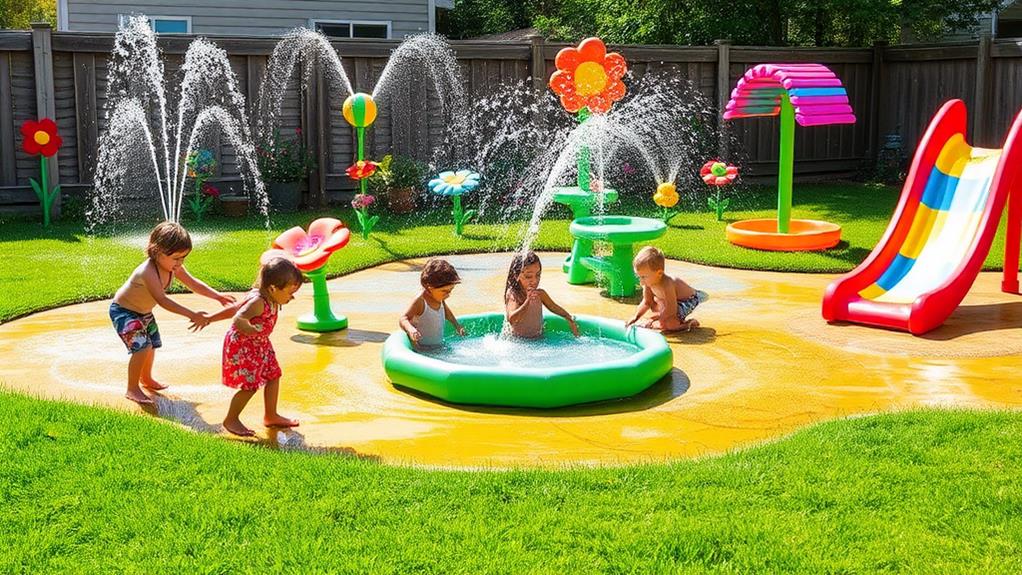
Moving from imaginative play structures to aquatic adventures, water fun zones offer refreshing entertainment for children during hot summer days. These areas can range from simple sprinklers to elaborate mini water parks, providing a safe and exciting environment for kids to cool off and play.
A popular option is the splash pad, featuring various water jets and sprayers that children can run through. These are low-maintenance and don't require standing water, making them safer for younger children.
For a more immersive experience, inflatable water slides combine the thrill of heights with aquatic fun.
For a natural approach, consider creating a shallow stream or pond area with smooth stones and gentle water flow. This not only provides a cooling play space but also introduces children to aquatic ecosystems. Rainwater collection systems can be integrated into water play areas, teaching kids about conservation while they enjoy the results.
When designing water fun zones, prioritize safety with non-slip surfaces and appropriate depths. Ensure proper drainage to prevent standing water and mosquito breeding. Regular maintenance and water quality checks are essential to keep the area hygienic and enjoyable for all.
Artistic Expression Areas
Within the realm of backyard renovations, artistic expression areas provide children with dedicated spaces to unleash their creativity and develop their artistic skills. These zones can be designed to accommodate various artistic mediums and activities, fostering imagination and self-expression.
A key element of an artistic expression area is a large chalkboard or whiteboard mounted on a fence or wall. This surface allows children to draw, write, and create temporary masterpieces. For more permanent artwork, consider installing an easel station with weatherproof storage for paints, brushes, and paper.
Incorporate a mosaic table or wall where children can arrange colorful tiles or stones to create patterns and designs. A sandbox filled with kinetic sand offers a tactile medium for sculpting and building. To encourage outdoor music-making, install weather-resistant instruments like chimes, drums, or xylophones.
Create a nature art station with bins for collecting leaves, twigs, and pebbles, which children can use to craft temporary installations. Finally, designate a gallery space where children can display their finished works, fostering a sense of pride and accomplishment in their artistic endeavors.
Gardening Spaces for Kids
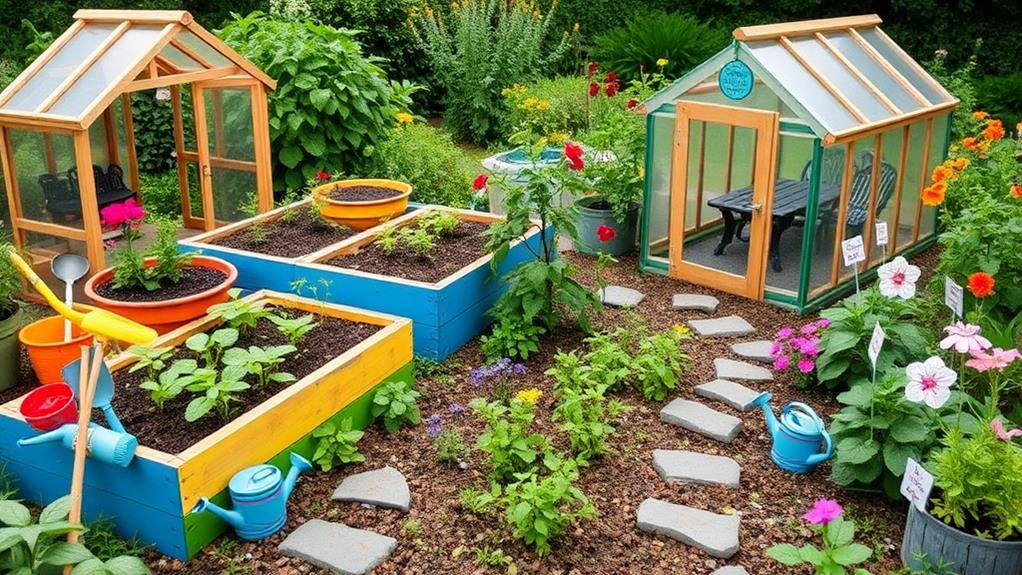
Creating dedicated gardening spaces for children in the backyard offers numerous educational and developmental benefits. These areas provide hands-on learning experiences about plant life cycles, nutrition, and environmental stewardship.
To design an effective children's gardening space, consider raised beds or container gardens at appropriate heights for easy access. Use child-sized tools and gloves to encourage participation and safety.
Choose fast-growing, hardy plants that yield quick results to maintain children's interest. Vegetables like cherry tomatoes, carrots, and lettuce are excellent choices, as are colorful flowers such as marigolds and sunflowers. Incorporate sensory elements by including herbs with distinct scents and textures. Create pathways between planting areas using stepping stones or mulch to prevent trampling of plants.
Include a small potting station where children can start seeds and learn about soil composition. Add a weather station with a rain gauge and thermometer to teach about climate's impact on plant growth. Finally, designate a composting area to demonstrate the cycle of decomposition and nutrient replenishment. This multifaceted gardening space will not only entertain but also educate children about nature and sustainability.
Outdoor Science Labs
Outdoor science labs extend the learning potential of backyard spaces beyond gardening, offering children a broader range of hands-on STEM experiences. These designated areas can be equipped with weather stations, allowing kids to track temperature, rainfall, and wind patterns. Simple tools like magnifying glasses, microscopes, and bug-catching kits encourage exploration of local flora and fauna.
A small workbench or table serves as a base for experiments and observations. Consider installing a whiteboard or chalkboard for note-taking and calculations. For astronomy enthusiasts, a telescope and star charts can transform the backyard into an observatory at night. Water-based experiments benefit from a dedicated sink or water source.
Safety should be a priority, with proper storage for chemicals and sharp tools. Incorporate recycled materials for sustainability lessons, such as using plastic bottles for terrariums or building bird feeders. Designate areas for long-term projects, like decomposition studies or crystal-growing experiments. Outdoor science labs can be tailored to various age groups and interests, fostering curiosity and critical thinking skills while providing an engaging alternative to indoor screen time.
Sports and Fitness Corners
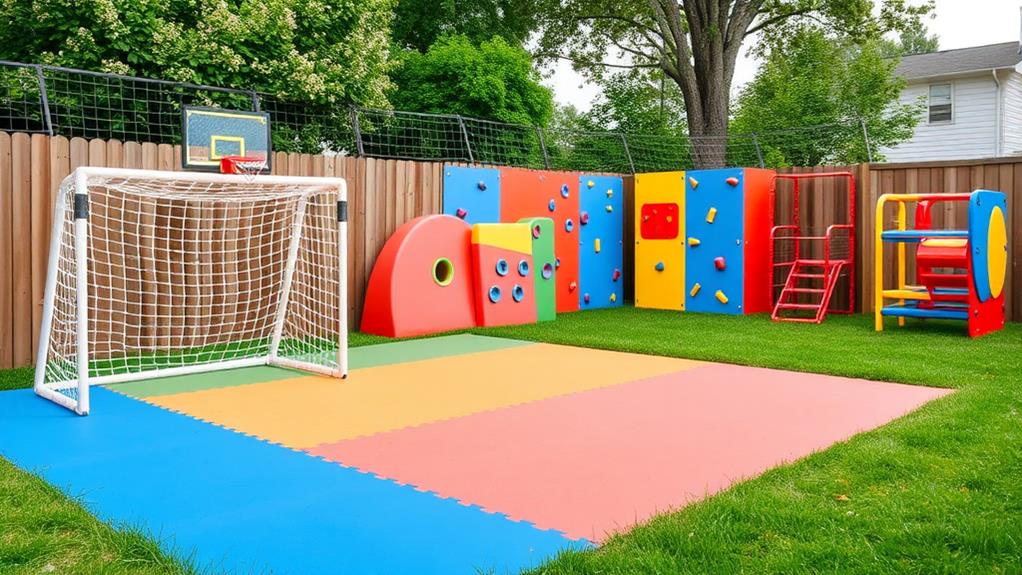
To promote physical activity and healthy lifestyles, incorporating sports and fitness corners in a backyard renovation can be highly beneficial for children. These dedicated areas encourage regular exercise, skill development, and outdoor play.
Consider installing a multi-sport court with adjustable equipment for basketball, volleyball, and badminton. This versatile space allows children to engage in various activities and develop different athletic skills. For younger kids, a mini soccer goal or a T-ball setup can foster early interest in team sports.
Create a fitness zone with weather-resistant exercise equipment such as pull-up bars, balance beams, and climbing walls. These structures challenge children's strength, coordination, and agility while providing a fun outdoor workout space.
Incorporate a running track around the perimeter of the yard, using materials like rubber mulch or artificial turf for a safe, cushioned surface. Add distance markers to encourage personal goal-setting and friendly competitions.
For additional variety, consider installing outdoor table tennis, a tetherball pole, or a horseshoe pit. These games offer opportunities for both individual practice and social interaction, catering to different interests and skill levels.
Cozy Hangout Spots
Cozy hangout spots are essential elements in a kid-friendly backyard renovation, providing children with comfortable spaces to relax, socialize, and engage in quiet activities. These areas can be designed to accommodate various preferences and age groups, ensuring that children have a designated space to unwind and enjoy outdoor time.
One popular option is creating a reading nook with weather-resistant cushions, bean bags, or hammocks nestled under a shaded area or within a small, open-air structure. This space can be enhanced with bookshelves or storage boxes to keep reading materials accessible and protected from the elements.
Another idea is to install a swing set with multiple seating options, such as traditional swings, a porch swing, or even hanging chairs. These provide a fun and relaxing spot for children to gather and chat with friends or siblings.
For older children, consider incorporating a small deck or patio area with comfortable seating and low tables. This space can serve as a spot for board games, crafts, or simply hanging out. Adding string lights or lanterns can create a cozy atmosphere for evening use, extending the enjoyment of the backyard well into the night.
Frequently Asked Questions
How Can I Ensure My Backyard Playroom Is Safe for Children?
To ensure a safe backyard playroom for children, install shock-absorbing surfaces beneath play equipment, secure structures properly, remove potential hazards, use child-safe materials, maintain regular inspections, and establish clear safety rules for children to follow during playtime.
What's the Ideal Budget Range for a Kid-Friendly Backyard Renovation?
Coincidentally, just as you ask, my neighbor completed a similar project! The ideal budget range for a kid-friendly backyard renovation typically falls between $5,000 to $15,000, depending on the scope and materials chosen for the project.
How Do I Maintain My Outdoor Playroom During Different Seasons?
To maintain your outdoor playroom year-round, regularly clean and inspect equipment, store or cover items during harsh weather, apply protective coatings to surfaces, trim surrounding vegetation, and adjust features seasonally for safety and comfort.
Are There Any Zoning Laws to Consider When Creating an Outdoor Playroom?
By Jove! Zoning laws can indeed impact outdoor playroom construction. Check local regulations for setback requirements, height restrictions, and permitted structures. Some areas may require permits for certain amenities. Consult your municipal planning office for specific guidelines.
What Age Range Should I Consider When Designing the Backyard Space?
When designing a backyard space, consider a wide age range from toddlers to teenagers. Incorporate versatile elements that can grow with your children, ensuring the area remains engaging and safe for various developmental stages over time.
Conclusion
In conclusion, transforming outdoor spaces into enchanting realms of discovery can significantly enhance children's developmental experiences. By integrating elements of adventure, nature, creativity, and physical activity, backyards evolve into multifaceted learning environments. These thoughtfully designed areas not only foster imagination and curiosity but also promote physical health and social interaction. Ultimately, a well-crafted outdoor playroom becomes an invaluable extension of the home, offering a safe haven for exploration, growth, and the cultivation of lifelong memories in the great outdoors.
